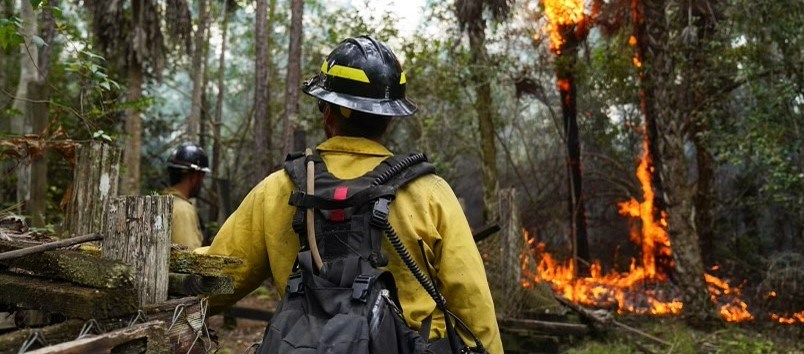How the Infrastructure Investment and Jobs Act Impacts Wildland Fire
NPS/M GUE The Infrastructure Investment and Jobs Act (legislation) signed in 2021, provided a historic investment in wildland fire management. The legislation provided funds to NPS to help mitigate and reduce wildfire risk, recover from wildfires, and increase recruitment and retention of the NPS wildland firefighter workforce through supplemental pay, permanent position conversions, and improvements to health, wellbeing, and training. The initial distribution of the Infrastructure Investment and Jobs Act will invest across all DOI bureaus and offices. The legislation includes $1.5 billion for DOI to invest in preparedness, fuels management, post-fire restoration, and fire science.
The legislation establishes the Wildland Fire Mitigation and Management Commission which will play a key role in recommending ways that federal agencies can better prevent, mitigate, suppress and manage wildland fires. It will also recommend policies and strategies on how to restore the lands affected by wildfire. Along with 11 federal members, the commission will be co-chaired by DOI, USDA, and Federal Emergency Management Agency (FEMA) leadership. Commission members represent federal agencies, Tribes, state and local municipalities, and private entities. The NPS share of funds will be used for fuels treatments, post-fire recovery and rehabilitation, wildland urban interface (WUI) improvement, wildfire prevention measures, wildfire preparedness, and road and fireline construction and repair. Section 40803 of the Infrastructure Investment and Jobs Act provides a supplemental salary increase of $20,000 per year, or 50% of base salary (whichever is less), for wildland firefighters employed by the USDA Forest Service and the DOI.
DOI and USDA Forest Service contributed support to the Office of Personnel Management (OPM) in the creation of a wildland firefighter occupational series to better reflect the unique responsibilities and skillsets of our firefighters.
The Wildland Fire Management series is a part of the long-term solution to ensure Federal wildland firefighters are supported, equitably compensated, and have a better work-life balance. For the past 50 years, there has been no specific Federal wildland firefighter job series or position descriptions and Federal jobs with a variety of roles and responsibilities including firefighting have all been incorporated in one broad job series referred to as the Forestry Technician GS-0462 job series. Moving forward the Wildland Firefighter Series will identify and provide job titles/specialties and a clear path to career advancement that reflects the true nature of the work. OPM has reestablished and renamed the former GS-0456 Forest and Range Control series to Wildland Firefighter series. Current firefighters (defined as Federal employees covered by the General Schedule Classification System under Title 5, United States Code Chapter 51, performing wildland firefighting work) will be able to choose whether to opt-in to the new wildland firefighter series or stay in their current occupations. Future firefighters will be able to apply for jobs specifically designated as wildland firefighters. Creation of the new series will provide a clear career path for wildland firefighters with defined requirements for advancement. This will also facilitate mobility between wildland firefighter jobs. A previous version of the 0456 series had been used many years ago for wildland firefighters. At the time, the fire season was shorter and the work more seasonal in nature. As a result, an occupational series geared toward a full-time, permanent wildland firefighter job was less relevant and useful. Accordingly, the Forest Service and DOI used other occupational series, such as forestry technician. But with the changing nature of the fire season and the need to employ wildland firefighters year-round, updating the 0456 series was appropriate. Firefighters will receive the supplemental salary increase payment whether or not they decide to move into the new wildland firefighter series, provided they continue to meet the eligibility requirements for payment. The new series does not affect retirement status or bargaining unit status. The new series, together with the associated interim temporary pay increases and focused efforts on long-term solutions, is aimed at lowering attrition rates and significantly improving retention of Federal wildland firefighters. Department of Interior Frequently Asked Qustions for Elect-In Process for the Wildland Fire Management Occupational Series, GS-0456 Updated November 1, 2023 In FY 2021, DOI converted nearly 550 wildland fire employees to permanent positions. The Infrastructure Investment and Jobs Act provides additional funding to continue our transition to a more permanent workforce capable of fire response and mitigation work on a year-round basis. That new funding will support the conversion of 1,000 positions across DOI and USDA Forest Service.
The Infrastructure Investment and Jobs Act directed the DOI and USDA Forest Service to address wildland firefighter health and wellbeing and specifically develop mitigation strategies to minimize exposure to environmental hazard and establish programs to recognize and address mental health needs. DOI and USDA Forest Service are developing a strategy to provide expanded training, education, and experiential learning opportunities to improve emergency response skillsets, business acumen, and land management competencies. Together, these improvements will provide much-needed stability, support, and improved career opportunities to enhance the resilience and effectiveness of our firefighting workforce. Wildland Fire Infrastructure Investment and Jobs Act Success Stories |
Last updated: May 13, 2025
